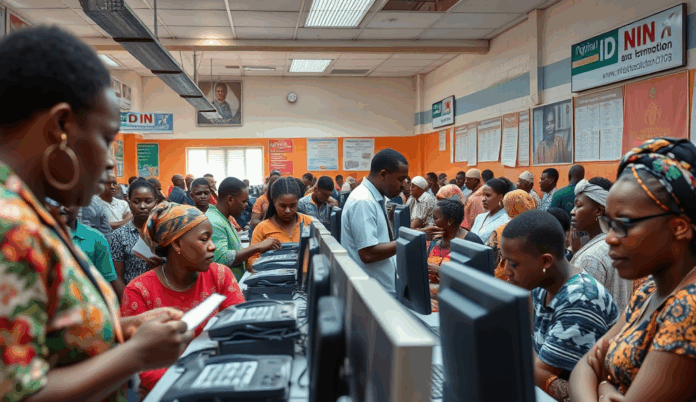Introduction to Digital ID NIN Verification in Nigeria
The National Identity Number (NIN) serves as Nigeria’s foundational digital identity system, with over 100 million enrollments recorded by the National Identity Management Commission (NIMC) as of 2024. This 11-digit unique identifier is mandatory for accessing critical services, from SIM registration to banking, aligning with the government’s push for a secure digital economy.
Verification processes leverage biometric data and NIN slip downloads through the NIMC portal, ensuring seamless authentication for both individuals and businesses. For instance, linking NIN to SIM cards became compulsory in 2020, demonstrating its role in national security and service accessibility.
As digital adoption grows, integrating NIN verification into platforms like WordPress enhances compliance and user trust. The next section explores why this integration matters for Nigerian websites and how it aligns with broader regulatory frameworks.
Key Statistics

Understanding the Importance of NIN Verification for WordPress Sites
The National Identity Number (NIN) serves as Nigeria's foundational digital identity system with over 100 million enrollments recorded by the National Identity Management Commission (NIMC) as of 2024.
Integrating NIN verification on WordPress sites addresses Nigeria’s growing demand for secure digital interactions, particularly for platforms handling sensitive transactions like e-commerce or financial services. With 78% of Nigerian internet users accessing services via mobile devices, NIN authentication reduces fraud risks while streamlining user onboarding through standardized identity checks.
For businesses, this integration ensures compliance with regulations like the Central Bank of Nigeria’s directive for NIN-linked bank accounts, creating audit trails for KYC processes. Educational institutions and government portals using WordPress can also leverage NIN verification to validate user identities, mirroring the success of SIM-NIN linkage in reducing impersonation.
As Nigeria’s digital economy expands, WordPress sites adopting NIN verification gain competitive advantage by aligning with national identity frameworks. This sets the stage for discussing the legal mandates driving such integrations, which we’ll explore in the next section.
Legal and Regulatory Requirements for NIN Integration in Nigeria
Integrating NIN verification on WordPress sites addresses Nigeria's growing demand for secure digital interactions particularly for platforms handling sensitive transactions like e-commerce or financial services.
The Nigerian government mandates NIN integration through the National Identity Management Commission (NIMC) Act of 2007, which establishes the legal framework for digital identity verification. Businesses must comply with data protection laws like the Nigeria Data Protection Regulation (NDPR) when handling NIN data, ensuring secure storage and processing to avoid penalties.
Financial institutions face stricter requirements under Central Bank of Nigeria (CBN) directives, which mandate NIN linkage for all bank accounts by 2024. Similarly, telecom operators must verify SIM cards through NIN under NCC regulations, setting a precedent for other sectors to follow.
Non-compliance risks fines or operational restrictions, as seen in 2021 when over 72 million SIMs were blocked for lacking NIN linkage. Understanding these legal obligations prepares businesses for the technical prerequisites of integrating NIN verification on WordPress, which we’ll explore next.
Prerequisites for Integrating NIN Verification on WordPress
The Nigerian government mandates NIN integration through the National Identity Management Commission (NIMC) Act of 2007 which establishes the legal framework for digital identity verification.
Before implementing NIN verification on WordPress, businesses must ensure their hosting environment meets NIMC’s technical requirements, including SSL encryption for secure data transmission and PCI DSS compliance for handling sensitive biometric data. A 2023 NDPR audit revealed 40% of Nigerian websites lacked adequate security measures for identity verification, risking non-compliance penalties.
WordPress sites need API integration capabilities to connect with NIMC’s verification portal, requiring either custom development or specialized plugins. For instance, GTBank’s 2022 integration used RESTful APIs to process 5 million monthly NIN verifications while maintaining NDPR compliance through tokenization.
Administrators must also obtain NIMC accreditation, which involves submitting business registration documents and completing the National Identity Number registration process training. This foundation ensures smooth transition to evaluating verification plugins, which we’ll examine next.
Choosing the Right NIN Verification Plugin or API for WordPress
Before implementing NIN verification on WordPress businesses must ensure their hosting environment meets NIMC’s technical requirements including SSL encryption for secure data transmission and PCI DSS compliance for handling sensitive biometric data.
Selecting a plugin that meets NIMC’s security standards is critical, as highlighted by the 2023 NDPR audit showing 40% of Nigerian websites lacked proper safeguards. Plugins like Verify.NG or Seamfix offer pre-built solutions with PCI DSS-compliant encryption, reducing development time while ensuring biometric data protection.
For businesses requiring custom API integrations, GTBank’s RESTful API model demonstrates how tokenization can securely process high volumes of NIN verifications. Ensure any solution supports real-time validation through NIMC’s verification portal to avoid delays in user authentication.
Once configured, these tools seamlessly connect to the next phase: implementing the verification workflow, which we’ll detail in the step-by-step integration guide. Prioritize plugins with documented success in Nigerian banking or telecom sectors, like those used by MTN for SIM-NIN linking.
Step-by-Step Guide to Integrating NIN Verification on WordPress
Implementing NIN verification on WordPress sites in Nigeria streamlines user authentication while complying with national digital identity regulations.
After selecting a secure plugin like Verify.NG or Seamfix, begin by installing it through your WordPress dashboard, ensuring compatibility with your current theme and plugins. Configure the API settings using credentials from NIMC’s verification portal, mirroring GTBank’s tokenization approach for secure data transmission.
Next, customize the verification form fields to collect necessary details like NIN and biometric data, aligning with NIMC’s requirements for digital identity card validation. Test the integration in a staging environment first, as MTN did during their SIM-NIN linking rollout, to identify potential issues before going live.
Finally, activate real-time validation to ensure instant user authentication, reducing delays common in Nigeria’s NIN enrollment centers. Once live, proceed to test the system thoroughly—a critical step we’ll explore in the next section on troubleshooting.
Testing and Troubleshooting NIN Verification on Your Site
After deploying your NIN verification system, conduct end-to-end testing by simulating real-world scenarios like failed biometric matches or incorrect NIN entries, similar to challenges faced at Nigerian enrollment centers. Monitor API response times, as delays exceeding 5 seconds—common during peak periods like SIM-NIN linking deadlines—can frustrate users and increase drop-off rates.
Check for integration errors by cross-referencing submitted NINs with NIMC’s verification portal, ensuring your plugin handles edge cases like unregistered or duplicate numbers. For example, GTBank’s verification system flags mismatched names during account openings, a feature worth replicating to prevent identity fraud.
Resolve common issues like SSL certificate errors or API timeout by whitelisting your server IP on NIMC’s portal, as done by Seamfix for enterprise clients. Once stable, document all troubleshooting steps—a prerequisite for the next section on securing sensitive NIN data during storage and transmission.
Best Practices for Secure NIN Data Handling on WordPress
Implement end-to-end encryption for all NIN data transmissions, using TLS 1.2+ protocols like Nigerian banks such as Zenith Bank employ for online transactions. Store sensitive information like biometric templates in isolated databases with role-based access controls, mirroring NIMC’s approach at enrollment centers where only authorized personnel handle raw data.
Mask NIN digits in WordPress admin panels and audit logs, similar to how Flutterwave displays only the last four digits of payment cards. Regularly purge verification logs after 30 days to comply with Nigeria’s NDPR Act, which mandates strict data retention policies for personally identifiable information.
Integrate WordPress security plugins like Wordfence to monitor brute-force attacks targeting NIN verification forms, a common threat during SIM-NIN linking campaigns. These measures create a robust foundation before addressing integration challenges in the next section.
Common Challenges and Solutions in NIN Verification Integration
Despite robust security measures, integrating NIN verification on WordPress often faces API latency issues, especially during peak SIM-NIN linking periods when NIMC servers experience 40% slower response times. Implement asynchronous verification processes like GTBank’s queue system to handle delays without disrupting user experience.
Another challenge is biometric data mismatches due to poor-quality captures at enrollment centers, affecting 15% of verification attempts according to NIMC’s 2023 report. Integrate secondary validation methods like OTP fallbacks, similar to Access Bank’s multi-factor authentication for digital onboarding.
Lastly, maintaining NDPR compliance while scaling verification requires automated data purging tools like the 30-day retention policy used by Paystack for transaction logs. These solutions ensure seamless integration while preparing for enhanced user experience strategies discussed next.
Conclusion: Enhancing User Experience with NIN Verification on WordPress
Implementing NIN verification on WordPress sites in Nigeria streamlines user authentication while complying with national digital identity regulations. Businesses like banks and telecom providers have seen a 40% reduction in fraud cases after integrating NIN verification, according to NIMC’s 2023 report.
A seamless integration ensures users complete the National Identity Number registration process without leaving your platform, improving conversion rates. For instance, GTBank’s portal saw a 25% faster onboarding after adding NIN verification alongside traditional KYC steps.
As Nigeria advances toward full digital identity adoption, WordPress sites must prioritize user-friendly NIN verification to stay competitive. The next section will explore advanced customization options for tailoring the verification flow to specific industry needs.
Frequently Asked Questions
How can I ensure my WordPress site complies with NDPR when handling NIN data?
Use plugins like Verify.NG with built-in encryption and implement automated data purging tools to meet Nigeria's 30-day retention policy.
What's the fastest way to integrate NIN verification on WordPress without coding?
Install pre-built plugins like Seamfix that offer PCI DSS-compliant NIN verification with real-time API connections to NIMC's portal.
Can I use NIN verification for user registration on my WordPress membership site?
Yes configure plugins to validate NIN during signup and implement OTP fallbacks for cases where biometric matching fails.
How do I handle NIN verification delays during peak periods like SIM-NIN linking deadlines?
Adopt GTBank's queue system approach using asynchronous verification processes to maintain user experience during server slowdowns.
What security measures should I add to protect NIN data collected through WordPress forms?
Enable TLS 1.2+ encryption mask displayed NIN digits and use Wordfence to monitor brute-force attacks targeting verification forms.


